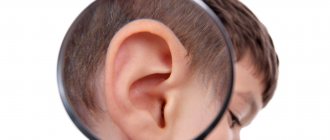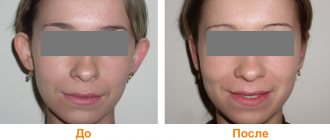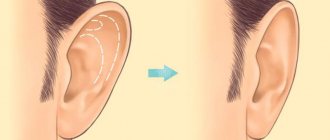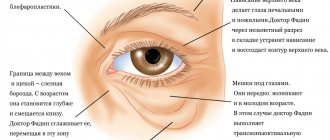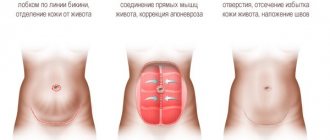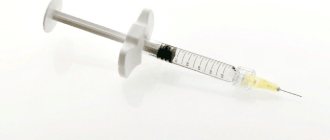Beautiful ears are one of the details of the overall external aesthetics. Otoplasty helps correct a number of cosmetic defects, including protruding ears, deformities, insufficient or excessive shell size, scars, consequences of injuries, and even partial or complete absence of ears. Modern surgical techniques are safe, so plastic correction can be prescribed even in childhood.
For successful correction, not only the qualifications and experience of the surgeon are important, but also the patient’s attitude towards the operation. Competent preparation and careful care during the rehabilitation period are the key to high-quality and quick recovery combined with an impressive aesthetic result. And one of the stages of preparation for intervention is taking tests and undergoing examinations prescribed by the doctor.
Who appoints?
To be able to undergo plastic surgery, the patient must undergo all examinations prescribed by the doctor. The patient receives a list of required diagnostic tests from the surgeon during the first consultation. As a rule, it contains procedures common to all. Additional examinations may be recommended on an individual basis. It is undesirable to ignore these recommendations, since without undergoing a complete list of examinations, the patient simply will not be allowed to undergo surgery.
Also, during otoplasty, tests can be prescribed by an anesthesiologist. The patient meets with the anesthesiologist after the surgeon so that the doctor can study information from the patient’s examinations and, based on the current state of health, choose the most optimal type and technique of anesthesia. But in some cases, the anesthesiologist may ask the patient to undergo additional diagnostics. This is necessary so that the doctor can choose the safest and most effective anesthesia and calculate the exact dosage of drugs without threatening the life and health of the patient.
Based on the results, the anesthesiologist selects medications and calculates the optimal dosage.
Ear plastic surgery (otoplasty)
Surgery to correct protruding ears
Those who live with such an unpleasant feature as protruding ears have to resort to various tricks in order to somehow hide protruding ears; the natural desire to wear open hairstyles is often limited and is considered an unattainable luxury.
Surgeries to correct protruding ears account for about 95% of all surgical interventions on the auricle.
In our clinic, correction of protruding ears is carried out using the latest CO2 laser from DEKA. Plastic surgeons try to select individual tactics for eliminating protruding ears for each patient so as to bring him as close as possible to the dream of neat ears.
Indications for surgery to eliminate protruding ears:
- Aesthetic dissatisfaction with the degree of “pressure” of the auricle to the head.
- Asymmetry of the “pressing” of the ears.
- Smoothed outer relief of the auricle, giving a “protruding” appearance to the ear.
- Aesthetic dissatisfaction with the result of aesthetic otoplasty performed previously.
After a detailed conversation and clarification of wishes, a computer simulation of the result of the operation is performed, which allows you to see and evaluate the expected effect in advance. After this, possible surgical options are discussed with the patient, from standard classical methods to otoplasty using a laser.
The advantages of the laser method of ear surgery are that it is bloodless (due to coagulation of blood vessels). As a result, a “dry” surgical field is created, which makes the surgeon’s work easier, shortens the operation time, and eliminates the formation of hematomas; the ability to work precisely and selectively with tissues.
The operation to eliminate protruding ears involves modeling a new form of ear cartilage. There are no strict standards, but it is believed that the line of the auricle along the outer edge should be parallel to the line of the cheek on the same side, and the angle between the plane of the auricle and the head should be approximately 30 degrees.
Correction of the ears is done under local anesthesia. If the patient is afraid or does not want to feel anything during the operation, otoplasty can be done under anesthesia. The incision is located on the back surface of the auricle, along the natural fold, which makes the scar almost invisible.
After surgery, you need to wear a compression bandage for 7 days. The sutures are removed after 7–10 days. Visible swelling is present for one to two weeks. You can evaluate the result of plastic surgery to correct protruding ears in 2–3 months.
If you have decided to have otoplasty, make time to see a plastic surgeon. During the consultation, the doctor will tell you about the features of the operation in each individual case, about contraindications; at the appointment, you will receive a list of the necessary preoperative examinations and agree on the date of the operation.
What's on the list
The list of mandatory laboratory tests includes:
- general studies (blood, urine),
- biochemistry (AST, ALT, bilirubin and others),
- electrolytes,
- glucose,
- coagulogram,
- HIV, HBS, HCV, RW,
- blood type and Rh factor.
Please note that laboratory diagnostic results have expiration dates. A significant part of the tests are valid for 14 days. Therefore, it is not recommended to submit them much in advance of the planned date of the operation.
Among the examinations that need to be completed are electrocardiography and fluorography; an ultrasound scan of the vessels of the lower extremities may also be required. The patient must have a physician’s report in his hands, issued based on the results of all diagnostic measures. In this way, the absence of contraindications is determined, in the presence of which it is impossible to perform otoplasty.
Research to prepare for surgery
Before the actual surgical intervention, it is necessary to carry out a set of procedures to prepare the patient for the operation. This complex includes:
- Complete blood count (CBC/DIFF) with leukocyte formula/ESCBC/DIFF) with leukocyte formula/ESR;
- Blood type, Rh factor;
- Blood chemistry
Find out more
Seeing a doctor in a timely manner will help maintain your health.
Don't delay treatment, call right now. We work around the clock. tel. (24 hours a day)
In what cases can correction be prohibited?
The operation is not one of the most difficult in plastic surgery and is prescribed even for children. But in some cases, unfortunately, it becomes impossible to make a correction. As a rule, various diseases, which are contraindications for most plastic corrections, serve as reasons for avoiding surgery. Otoplasty is not performed on people who suffer from diabetes (subcompensation or decompensation), cancer, infection or the acute phase of a chronic disease.
The operation is also contraindicated for those who have disorders of the blood coagulation system. Correction cannot be carried out during pregnancy, breastfeeding and is not recommended during menstruation.
Some contraindications are temporary, and after the symptoms disappear, correction becomes possible. Others are permanent. If such indications exist, surgery is not possible.
About the age of the operation and its patients
The first ear surgery was performed in 1881. Gradually, otoplasty improved, scientists and plastic surgeons proposed various methods of performing the operation. By the 21st century, approximately 200(!) methods for correcting the shape and size of the ears have accumulated. The choice of one or another method of ear plastic surgery is determined not by the surgeon’s preference, but by the specific indication for surgical intervention.
But, perhaps, the main difference between otoplasty and other plastic surgeries is the age of the patients. A person’s auricle is fully formed by the age of 5, which means that from the age of 5-6 you can safely contact specialists and correct this defect. Agree, your children have absolutely no need to hear ridicule and bullying from their peers! Ear surgery can also be done at a later age. Sometimes the patients are well-established individuals over 40 years of age, for whom ear correction is a long-standing and cherished dream.
What else do you need to know?
On the eve of the expected test, it is highly recommended to exclude active sports, alcohol and stressful situations. Blood is donated strictly on an empty stomach. Ideally, it is advisable to fast for at least 6 hours before your due date. It is better to stop smoking an hour before blood sampling. Before collecting venous blood, you should spend 15 minutes in a calm state of rest.
It is advisable to be in a calm state before and during donating blood.
All medical documentation must be in Russian and prepared on special forms. The results must be confirmed by the seal of the institution and the signature of the medical specialists who issued the conclusion. Only original forms with results are accepted into the clinic. The doctor does not accept copies of reports.
Otoplasty at the Anthurium clinic
In Barnaul, the Anthurium clinic has been performing otoplasty since 2003. Modern equipment, experienced surgeons, a cozy hospital, caring and professional clinic staff, discounts on rehabilitation procedures are the undoubted advantages of our clinic! We will do everything to make you or your child as comfortable as possible with us!
The clinic’s doctors are well aware that any aesthetic defect can lead to psychological complexes, and protruding ears are at the top of this list. Therefore, otoplasty is performed for children 6-7 years old before school, so that the child does not have problems with social adaptation in the new team.
Elimination of aesthetic defects of the ears or their reconstruction is a patient’s step into a new full life, which we help him take!
Preparing for surgery
In addition to the obligation to undergo tests before otoplasty, the patient must also follow some recommendations for preparing for plastic correction. Provided that all diagnostic measures have been completed successfully and no contraindications have been found, a date for the planned operation is set.
Two weeks before this day, you must stop taking all medications that thin your blood. These are medications such as aspirin or ibuprofen. In general, taking any medications should be discussed in advance with your surgeon, who will tell you which medications should not be taken before surgery.
You should also avoid consuming products containing nicotine and alcohol in advance. This must be done at least three days before the intervention. Directly on the day of the correction itself, in the morning you are not allowed to eat or drink anything.
What is tympanoplasty
Tympanoplasty
is a surgical intervention for chronic purulent otitis media, an operation aimed at restoring damaged structures of the middle ear, eardrum and improving hearing.
Unfortunately, chronic suppurative otitis media is a common disease. Its development is facilitated by improper and untimely treatment of acute purulent otitis media, which can result in perforation of the eardrum (hole in it). Pathogenic bacteria enter the tympanic cavity through the perforation, so ear discharge may persist for many years.
Untimely treatment of purulent otitis leads to serious complications and can cause diseases such as meningitis, cerebral thrombosis, and brain abscess.
The inflammatory process is not limited to the mucous membrane of the tympanic cavity, but also leads to the destruction of bone structures - the walls of the tympanic cavity, the auditory ossicles. Over time, not only progressive hearing loss occurs, but there may also be severe purulent complications - meningitis, cerebral thrombosis, brain abscess
.
Rehabilitation
After the operation, the patient must follow all the doctor’s instructions and not violate any prohibitions so that the recovery process proceeds normally. Postoperative sutures should not be wetted. Requires daily treatment with a disinfectant. After the correction, you can temporarily not engage in sports, do thermal procedures (bath, sauna, bath) or sunbathe. Be sure to wear a compression bandage that fixes the position of the tissues.
Depending on the condition of the body and the patient’s well-being, the doctor may prescribe certain medications. For example, if there is severe discomfort from pain in the intervention area, analgesics may be prescribed. A course of antibiotics may be indicated to prevent the development of infection.
